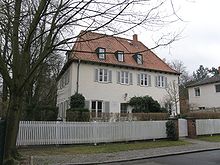|
Bonhoeffer family The Bonhoeffer family is a German family that, though originating in the city of Nijmegen, has been documented in the city of Schwäbisch Hall from 1513 onwards. Among the family's most notable members are Dietrich Bonhoeffer and Klaus Bonhoeffer, both executed in the last days of World War II by Adolf Hitler's government for their different resistance activities against the Nazi régime. HistoryKarl Bonhoeffer was born on 31 March 1868 in Neresheim, Württemberg, the son of Friedrich von Bonhoeffer (1828–1907), presiding judge in Ulm, and his wife Julie, née Tafel (1842–1936). He studied medicine at the universities of Tübingen, Berlin and Munich; in 1892 he obtained his doctorate supervised by Paul Grützner. After working as a physician for several years, he became director of the Breslau psychiatric hospital and also habilitated at the Breslau University, under Carl Wernicke, in 1897. In 1898, Bonhoeffer married Paula von Hase (1876–1951), a granddaughter of Protestant theologian Karl Hase (1800–1890). Karl and Paula Bonhoeffer had eight children, whom they educated at home:
 In 1912 Karl Bonhoeffer succeeded Theodor Ziehen as professor of psychiatry at the Berlin Charité hospital. He became a prominent psychiatric consultant on culpability and insanity defense, who, after the Reichstag fire of 1933 attested Marinus van der Lubbe's capacity for guilt in the Leipzig Trial. As a follower of Emil Kraepelin, he worked on differential diagnosis to delimit schizophrenia and paranoia from a delirium as organic brain syndrome. He opposed the ideas of Freud and Jung and, although initially in favour of sterilization programmes, it is said he refused to participate in the Nazi-sponsored sterilizations started by the Law for the Prevention of Hereditarily Diseased Offspring enacted in 1933. Karl Bonhoeffer officially retired in March 1936, though he continued to give scientific lectures until 1938. His successor at the Charité Hospital, Max de Crinis, was deeply involved in the Nazi abuse and murders of the Action T4 "euthanasia" programme. Two sons of the Bonhoeffers and two sons-in-law were executed by the Nazis for their part in the German Resistance. In addition, Paula Bonhoeffer's cousin, Paul von Hase, was also executed for a role in the Resistance, and the couple's daughter, Christel von Dohnanyi, and one grandson-in-law, Eberhard Bethge, were imprisoned by the Nazis but survived. Dietrich, as a Protestant theologian became a member of the Confessing Church, joined the German resistance to fight against the evils of Nazi Germany, was arrested in 1943, and executed on 9 April 1945 at Flossenbürg concentration camp, with his brother-in-law Hans von Dohnányi. Klaus Bonhoeffer and his brother-in-law Rüdiger Schleicher likewise joined the resistance, were arrested, and, with other conspirators of the 20 July plot, found guilty by the "People's Court" (Volksgerichtshof) under presiding judge Roland Freisler on 2 October 1944; they were shot by Gestapo henchmen on the night of 22–23 April 1945 near the ruins of Berlin Lehrter Bahnhof, while Red Army forces entered the city. Karl Bonhoeffer continued to work as a professor after the war. He died after a stroke on 4 December 1948 in Berlin. References
Wikimedia Commons has media related to Bonhoeffer family. |